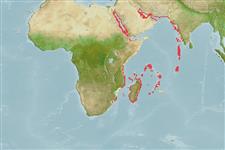>
Gobiiformes (Gobies) >
Gobiidae (Gobies) > Gobiinae
Etymology: Trimma: Greek, trimma, -atos = something crushed (Ref. 45335).
Environment: milieu / climate zone / depth range / distribution range
Écologie
marin récifal; profondeur 2 - 20 m (Ref. 57688). Tropical
Western Indian Ocean: Gulf of Aqaba to the islands of the western Indian Ocean as far south as Tulear, Madagascar; east to the Cargados Carajos shoals north of Mauritius
Taille / Poids / Âge
Maturity: Lm ? range ? - ? cm
Max length : 4.0 cm TL mâle / non sexé; (Ref. 11344)
Description synthétique
Clés d'identification | Morphologie | Morphométrie
This species is distinguished by having the following characters: with a frontal ridge that slopes variably (steeply, and with a ridge, to gradually, without a ridge) into the interorbital trench; postorbital trenches may be steep or shallow sided; posterior nasal opening adnate to eye; second spine of first dorsal fin occasionally elongate, third spine is not; eight or more elements in the second dorsal; fifth pelvic fin ray branched multiple times dichotomously, appearing bushy; 18 or more pectoral rays; scales on head; body color brown-red with five diffuse white vertical bars, between mid-peduncle to just anterior to origin of first dorsal; facial pattern with two white bars under orbit,
and one irregular white bar over vertical limb of the preopercle; a pair of thin fleshy lappets, half a pupil width apart, a quarter pupil width behind the frontal ridge, on either side of dorsal midline of the nape; epibranch of the first gill arch lacks gill rakers (Ref.57688).
Collected over coral reef flats rising above the rubble-sandy bottom (Ref. 57688).
Life cycle and mating behavior
Maturities | Reproduction | Spawnings | Egg(s) | Fecundities | Larves
Winterbottom, R., 1995. Red Sea gobiid fishes of the genus Trimma, with the description of two new species. Rev. Fr. Aquariol. 22(3-4):93-98. (Ref. 13694)
Statut dans la liste rouge de l'IUCN (Ref. 130435)
Menace pour l'homme
Harmless
Utilisations par l'homme
Outils
Articles particuliers
Télécharger en XML
Sources Internet
Estimates based on models
Preferred temperature (Ref.
123201): 24.7 - 29.1, mean 27.5 °C (based on 537 cells).
Phylogenetic diversity index (Ref.
82804): PD
50 = 0.5000 [Uniqueness, from 0.5 = low to 2.0 = high].
Bayesian length-weight: a=0.01023 (0.00477 - 0.02194), b=3.02 (2.84 - 3.20), in cm total length, based on LWR estimates for this (Sub)family-body shape (Ref.
93245).
Résilience (Ref.
120179): Haut, temps minimum de doublement de population inférieur à 15 mois (Preliminary K or Fecundity.).
Fishing Vulnerability (Ref.
59153): Low vulnerability (10 of 100).
Nutrients (Ref.
124155): Calcium = 260 [125, 651] mg/100g; Iron = 1.32 [0.64, 2.58] mg/100g; Protein = 18.3 [16.3, 20.0] %; Omega3 = 0.159 [0.063, 0.354] g/100g; Selenium = 25 [10, 56] μg/100g; VitaminA = 124 [32, 468] μg/100g; Zinc = 3.23 [1.98, 5.00] mg/100g (wet weight);
